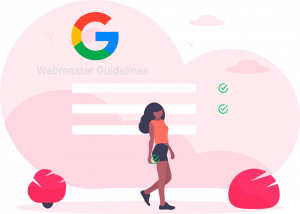In the digital marketing world, the bad guys and the good guys all have the same end goal.
What sets them apart is the way they go about achieving this shared vision.
We admit it.
Before starting Tabtimize, we may have each worked with tactics (knowingly and unknowingly) that weren’t exactly Google-approved.
Some of them worked temporarily, but mostly, the results were short-lived.
And frankly, the risks aren’t worth it.
Working with White-hat SEO has given us the results we were really looking for but didn’t put the effort into doing.
This is why we’d like to shed light on what to do and not to do when it comes to White-hat link building.
In this post, we also want to clarify the gray areas in SEO that can make White-hat techniques confusing.
If you want to learn about legitimate SEO techniques that can bring steady, sustainable results—you’ll want to read on.
Ready to pick a side?
Take a shortcut and jump to the findings and conclusions:
- What does White-hat mean in SEO?
- Why are White-hat SEO techniques important?
- What about Black-hat or even Gray-hat SEO?
- What’s the worst that can happen if I become Black-hat?
- What White-hat link-building techniques should I focus on?
Why should I care about link building?
Over time, marketing professionals have become more aware of the impact link building can have on their SEO efforts. So much so that:
57% of B2B marketers believe that SEO generates more leads than any other marketing initiative. (Hubspot)
Additionally,
49% of marketers report that organic search has the best ROI of any marketing channel. (Search Engine Journal)
Statistics like that are hard to ignore.
They also prove that SEO and link building aren’t just buzzwords.
Since the power of backlinks is now common knowledge, many SEO pros go to great lengths to achieve them.
They sometimes resort to less-than-clean tactics that can damage their reputation and get them penalized.
What does White-hat mean in SEO?
It’s important to differentiate between the practices that will build your page’s traffic organically vs. those that can get you penalized by Google.
Doing things the Google-approved way is called White-hat SEO and involves one simple rule: respecting and following the search engine guidelines.
White-hat SEO requires time and dedication to building consistently valuable content. Though you can’t expect results overnight with this method, it does ensure that you will see sustainable and continued growth in the long-run.
White-hat SEO is an approach that focuses on creating value for your domain with the user in mind, not just the search engine.
This means tactics that are used to try to “game” the search engine isn’t an option.
What do we mean by that?
White-hat SEO doesn’t use spammy techniques to trick Google, such as creating auto-generated content and stuffing it with keywords hoping to get traffic.
Or buying and selling low-quality backlinks on link-farms and PBNs.
In short, if you’re going to do things the White-hat way, you’ll have to put in the work.
Why are White-Hat SEO techniques important?
White-hat SEO techniques are so important because they are fundamental in upholding Google’s mission and values.
Google aims to organize the world’s information and make it universally accessible and useful.
The keyword to remember here is useful.
Can you imagine how chaotic the search engine would be without White-hat SEO?
You wouldn’t be able to find any relevant results for your search!
Worse, spam techniques like “cloaking” could lead you to click on something thinking it’s relevant, only to be redirected to a shady website such as pill affiliates or porn.
Would you use Google as often as you do?
Probably not.
White-hat SEO is crucial because it benefits both the search engine and the users. Without manipulative tactics, the search engine algorithm can pick up and rank only the content that is the most relevant for your searches.
More relevant results = more people using search engines.
Site owners also benefit by not having to resort to shady practices and compromising their reputation to get traffic.
A win-win situation all around ?.
What about Black-Hat or even Gray Hat SEO?
So now, we’ve established what constitutes White-hat SEO. We know that it is value-centered with user intent at its core.
Black-hat SEO on the other hand is riskier and involves using tactics to manipulate the search engine and ranking results.
It’s important to note, however, that both Black-hat and White-hat SEO have the same end-goal, which is increasing organic traffic.
But how they go about achieving it are two very contrasting methods.
In essence, Black-hat SEO uses shady practices to fake “relevance” to users.
It can range from small manipulative tactics to game the search engine to more dangerous activities.
Black-hat backlink building
In case you missed our article on how to build contextually relevant links, we define backlinks as your online reputation. They act as a vote of confidence between domains.
Think of it as a type of referral system.
Contextually relevant links, in particular, signal your trustworthiness to Google.
When SEO’s dabble in Black-hat link building, they try to trick search engines into thinking they are “trustworthy” websites. They do this by buying multiple spam links from irrelevant domains.
Mostly those links are bought from link farms and aren’t topically related to the domains they link out to. This means there is zero added value to users when they click on the links, bringing down the overall user experience.
More Black-hat SEO practices
Besides using spammy links, Black-hatters often produce auto-generated content stuffed with keywords. Usually created just to gain traffic from search engines, the content isn’t valuable for users.
Black-hat SEO can become more extreme and be unethical, especially when used against competitors.
Some examples of this can be attacking a rival website with spam to boost your own rankings while bringing down theirs.
If activities like hacking are discovered, there can also be legal repercussions.
What is Gray-hat link building? Should I use it?
Gray-hat SEO is essentially what its name implies. A combination of both Black and White-hat techniques.
Gray-hat practices can vary from slightly infringing on Google guidelines to serious violations, and should only be used at your own risk.
Some examples of Gray-hat SEO techniques are:
- Buying Links: Though it’s a frowned upon practice, buying links is actually quite common in the SEO world. Buying irrelevant links from link farms, PBNs and FFA sites is a big no-no, both for your users and the search engines, and can cause harsh penalties. SEO agencies that have the budget to do so often buy editorial or authority links at high prices. The average price of a more relevant link can range from €100s to €1000s of Euros. It is still considered a bad idea because these links were technically not “built” organically and create an uneven playing field for those that are actually working to create great content for their viewers.
- Buying Social Media Followers & Likes: Paying for likes and followers is a fast (but dishonest) way of gaining status on social media. These sneaky tactics involve violating social media guidelines and purchasing fake bots to follow your social media accounts. This can have an exponential effect on gaining new organic followers, as social media users are more likely to follow accounts that already have a large following.
- Leaving Fake Reviews: Leaving fake reviews to boost your business strategy or bring down a competitor is a shady practice that isn’t without consequences. The vast majority of consumers (88% to be exact) trust online reviews just as much as personal recommendations. This is purposely misleading and can harm your business’ reputation irreversibly if discovered. Thankfully, Google can detect when reviews are being purchased or if content creators are faking “virality”, and will take down purchased posts. To put a cap on purchasing “momentum” on social media, Google can program its bots to not share your content if it’s suspicious.
What’s the worst that can happen if I become Black-Hat?
Lots of people and companies have dabbled in Black-hat practices, either knowingly or unknowingly.
But, Google’s algorithms are sophisticated. With its regular updates and technological advancements, abnormal activity doesn’t go unnoticed for long.
Google catches everyone in time. Don’t believe us? Just ask Forbes and JC Penny.
Those are just two high-profile cases of many that have their reputation damaged by Black-hat SEO. But what can happen to the rest of us if we get caught?
If you fall into using Black-hat tactics, you risk facing some harsh penalties. In fact, most of the toughest SEO penalties have involved Black-hat techniques. Often when caught, you can face multiple penalties at once or risk getting delisted from the index altogether.
Though it may seem tempting or “easier” to go the Black hat route, your rankings and reputation will plummet.
Tabtimize Tip?: Having a big marketing budget won’t help you if you’ve been de-indexed by Google. Even less harsh penalties can set you back severely and can take months, and possibly years, to fix.
What White hat link-building techniques should I focus on?
Thus far, we’ve covered all the potential problems you could run into as a Black-hat SEO. Finally, let’s dive into some solutions!
So how can you avoid all these scary things from happening to you?
Follow these simple guidelines.
- Content promotion the right way: Google’s bots crawl billions of web pages a day. They sift through endless amounts of content and place the most relevant results on the top spots on SERPs. It’s really tough to capture the top positions, and those that do, know that their content has to capture user intent. It’s not enough to just create great content that is relevant to your audience. That’s only half the work. You want to make sure that your content doesn’t go unnoticed. Besides making sure that your posts are well optimized (use keyword research, meta-data, relevant anchor text, etc.), share your work on platforms that could be relevant to your niche.
- Building relationships with PR and Subject Experts in your niche: Building relationships with other blog owners, industry experts, and PR companies is a great way to introduce your content to a larger audience and interact meaningfully within your online communities. Establishing rapport and engaging in dialogue with others can be an effective way to earn natural links and grow your user base, organically. If you’re curious how you can gain access to PR companies and respond to their pitches, we outline some of the best platforms to use in this article.
- Use the Tabtimize Link Prospecting Tool: Creating stellar content and promoting it is hard work. But nothing is tougher in link building than the prospecting and outreach aspect. Thankfully, we’ve put a lot of thought into how we could take the hassle out of manual link building, so you don’t have to do it. The Tabtimize platform uses machine learning to do all the time-consuming research and find you only contextually relevant link opportunities. Specifically designed to simplify prospecting, our Link Prospecting Tool allows you to see the link opportunities that have the highest contextual relevance to your content. It’s that simple!
Tabtimize Tip?: The Tabtimize platform uses NLP models and also has semantic understanding capabilities that allow it to identify important information. This ranges from the content topic, keywords, and much more. Once the data is collected, the algorithm can break down the exact relevance between two pages down to %points (a metric we’ve coined as the Link Relevance Score, or LRS).
Fun Fact: The LRS or Link Relevance Score is a metric exclusive only to Tabtimize as we are currently the only platform that can quantify relevance.
Closing Comments
SEO is a crucial element of any website or online business. Choosing to go about Search Engine Optimization the right way can create more meaningful conversions for your business.
As tempting as it can be to go down the “easy” route, the risks associated with Black and Gray-hat SEO techniques just aren’t worth it. White hat link building is more work, but the results will be sustainable and enjoy continuous growth in the long-term.
Are there any White-hat SEO techniques that you prefer over others? Let me know in the comments below.



